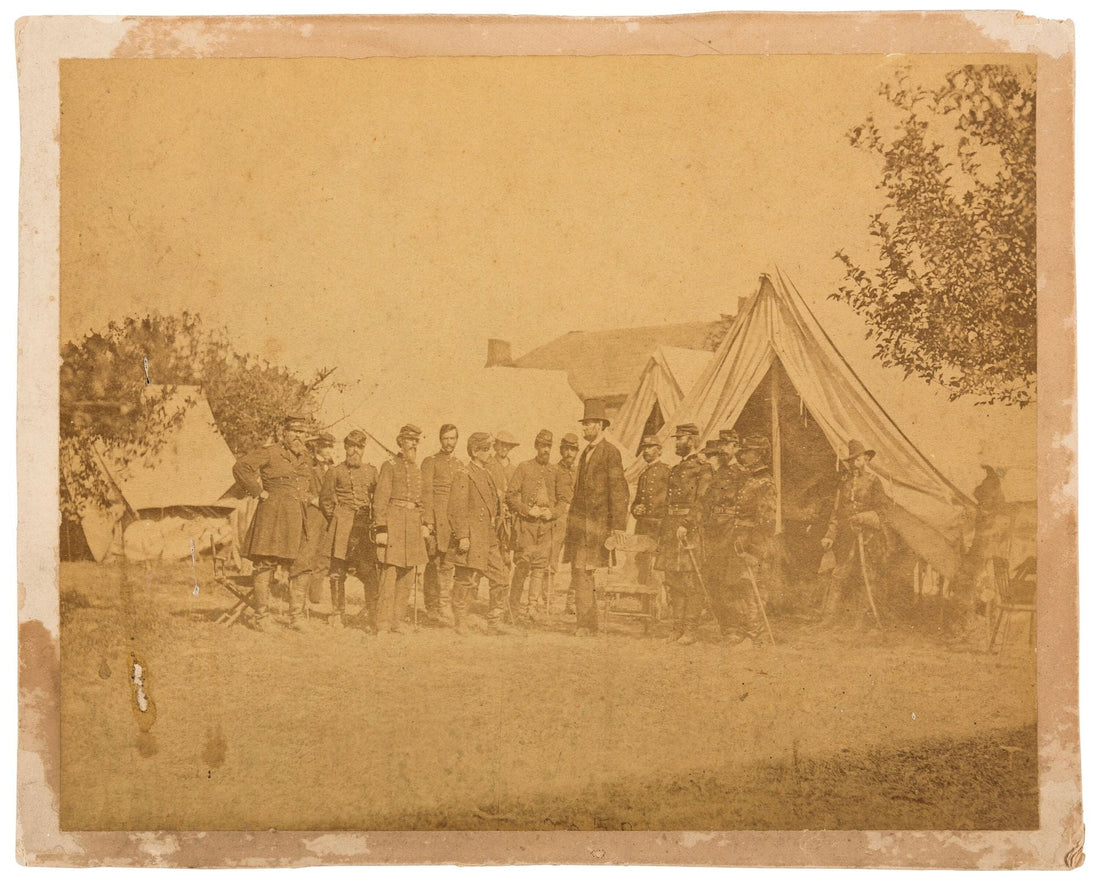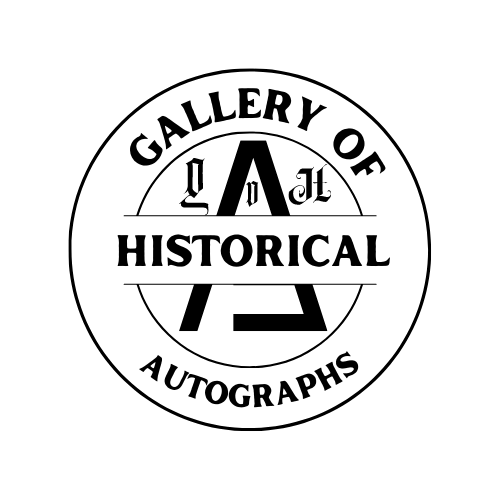
A Rare Glimpse of Leadership: President Lincoln at Antietam
Share

Alexander Gardner’s albumen photograph of President Abraham Lincoln at the Antietam battlefield, taken on October 3, 1862, offers a unique visual record of a pivotal moment during the Civil War. Measuring approximately 9.25" x 7.25" and mounted on its original 10" x 8" backing, this image shows Lincoln standing among Union officers, including General George McClellan, against the backdrop of field tents. Along with the photograph, a handwritten note on the verso provides additional historical details about the president’s visit.
Historical Context: Autumn 1862

Aftermath of Antietam: The Battle of Antietam (September 17, 1862) was the bloodiest single-day battle in American history. While both sides suffered severe casualties, the Union’s ability to halt Confederate forces gave President Lincoln the chance to issue the Preliminary Emancipation Proclamation (announced on September 22, 1862). This shift changed the character of the war, signaling the Union’s intention to end slavery.
Lincoln’s Visit: Arriving at Harper’s Ferry around October 1, Lincoln met with his generals to assess the army’s readiness and to review the battlefield. The battle had concluded only days before, and the Army of the Potomac was still recovering and reorganizing. The visit served as both a morale check for the troops and a strategic discussion with McClellan about future engagements.
Union Leadership Tensions: Lincoln’s trip came at a time of ongoing friction between the president and General McClellan. Critics in Washington believed McClellan was too slow to pursue the retreating Confederate army. The photograph captures an important phase of their professional relationship as they discussed the direction of the war.
Alexander Gardner: The Photographer Behind the Image
 Alexander Gardner (1821–1882) was a Scottish-born photographer whose work profoundly shaped how the public viewed the Civil War. Initially engaged in journalism in Scotland, Gardner eventually moved to the United States, where he managed Mathew Brady’s Washington, D.C. gallery. Dissatisfied with Brady’s practice of not always crediting his assistants, Gardner established his own studio in 1863 and began producing some of the most influential wartime images of the era.
Alexander Gardner (1821–1882) was a Scottish-born photographer whose work profoundly shaped how the public viewed the Civil War. Initially engaged in journalism in Scotland, Gardner eventually moved to the United States, where he managed Mathew Brady’s Washington, D.C. gallery. Dissatisfied with Brady’s practice of not always crediting his assistants, Gardner established his own studio in 1863 and began producing some of the most influential wartime images of the era.

Gardner distinguished himself by taking his camera equipment onto active battlefields—a difficult and sometimes dangerous feat given the cumbersome nature of early photographic technology. His dedication to documenting the war’s realities set new standards in the emerging medium. In 1866, Gardner published the two-volume Gardner’s Photographic Sketch Book of the Civil War, featuring 100 albumen prints accompanied by descriptive text. This publication offered stark and unflinching portrayals of battle sites and war-torn landscapes, ensuring that Gardner’s name would be forever linked with Civil War documentation.
The Photograph’s Significance and Condition
Early Battlefield Photography: Gardner’s image of Lincoln at Antietam exemplifies the power of photography to convey the immediacy of wartime leadership. Capturing Lincoln, McClellan, and other officers in the field tents underscores the personal and strategic gravity of the situation just days after a major battle.
Preservation Over Time: Despite its age, the print retains impressive clarity. The original 10" x 8" mount shows typical signs of wear, including minor edge loss, staining, and abrasions. These marks of historical passage reflect the artifact’s long journey through various custodians and collections.
Handwritten Transcription: On the verso, a detailed account of Lincoln’s battlefield visit provides further context. This text, likely penned by someone close to the events, enhances the artifact’s worth by merging visual imagery with written historical record.

Civil War Photography

Civil War photographs represent one of the earliest and most transformative uses of photography as a documentary medium. For the first time, the harsh realities of battlefields and military encampments were captured and disseminated to the broader public, challenging romanticized notions of warfare. Photographers like Mathew Brady, Alexander Gardner, and Timothy O’Sullivan traveled with cumbersome cameras and darkroom wagons, developing images in the field under difficult conditions. The resulting albumen prints offered unprecedented visual evidence of the conflict’s aftermath, including both the carnage of battle and the daily lives of soldiers. These images not only shaped public perception of the war at the time but also remain indispensable historical records, providing direct insight into a moment that defined the nation’s evolution.
Collectible Value and Recent Sales
 Civil War photographs, especially those featuring President Lincoln, remain highly sought after among collectors, historians, and photography enthusiasts. Gardner’s works have proven consistently desirable due to their scarcity and the photographer’s renowned legacy. Illustrating this, an example of "President Lincoln at Antietam" from Gardner’s Photographic Sketch Book of the Civil War sold for $23,750.00 in December 2023. The example we were so lucky to offer just sold in a private sale and we were glad to have it in our private collection for 4 years.
Civil War photographs, especially those featuring President Lincoln, remain highly sought after among collectors, historians, and photography enthusiasts. Gardner’s works have proven consistently desirable due to their scarcity and the photographer’s renowned legacy. Illustrating this, an example of "President Lincoln at Antietam" from Gardner’s Photographic Sketch Book of the Civil War sold for $23,750.00 in December 2023. The example we were so lucky to offer just sold in a private sale and we were glad to have it in our private collection for 4 years.
